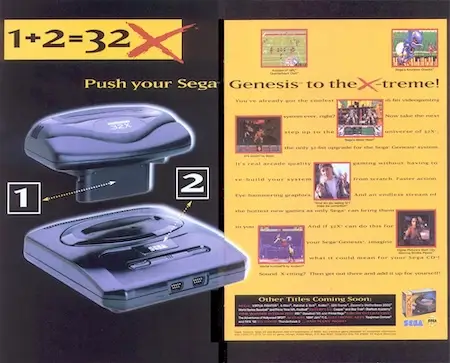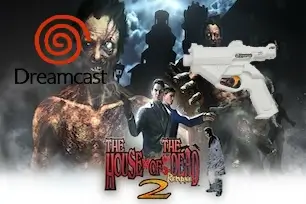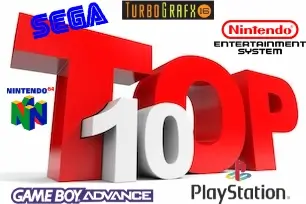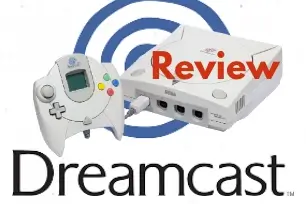Probably no console manufacturer lost the initiative worse than Sega did after it slayed the dragon known as the Nintendo Entertainment System. In 1992, on the heels of a gambit that saw Sega bundle the Genesis system with Sonic the Hedgehog, Sega managed to capture a staggering 60 percent of the market share, this less than two years after controlling a paltry 10 percent.
But by 1994 the honeymoon was over. Despite strong sales of the Genesis system in North America, sales of its equivalent Mega Drive in Japan were foundering. So rather than hurl every sinew of Sega's strength at the upcoming release of their next-gen gaming console, the Sega Saturn, Sega instead focused on hardware add-ons such as the 32X.
The Table of Contents
The Sega 32x system was a perfect storm of poor timing, a library of bad games, and bizarre marketing.
The Release
- The idea was to offer Sega Genesis owners an add-on that boosted the system's 16-bit graphics to 32-bit via two central chips and a processor with 3D
 capability. Retailing for $159.95, it would be an interim system designed to safeguard Sega's hold in the console marketplace while paving the way for the release of the Saturn.
capability. Retailing for $159.95, it would be an interim system designed to safeguard Sega's hold in the console marketplace while paving the way for the release of the Saturn.
- Sega apparently decided to do this backwards. Sega released the Saturn in Japan in November 1994 followed by the North American release of the Sega 32X that very same month. Sega then pushed the North American release of the Saturn forward to 1995, the result being that the 32X didn't have any time to find its footing in the console industry.
The Sega 32x Game Library:
- All told, around 40 games were released for the Sega 32X, but Sega had initially promised much more. However, because they rushed the 32X to market, they didn't have time to develop new in-house titles. The same could be said for third-party developers, who preferred to focus their attention on upcoming consoles like the Saturn, PS1, and the N64.
- The quality of the games Sega released for the 32X was generally terrible. "Doom," that runaway PC hit, was probably the 32X's most well-received title, yet it fell far short of the quality the same game offered on the PC and Atari Jaguar. It almost seemed like Sega's developers could not or would not capitalize on the system's 32-bit capabilities.
- This was evident in the fact that most games released for the 32X were slightly upgraded Genesis hits gamers already owned, like "Mortal Kombat II" and "NBA JAM TE." This all but killed the goodwill the 32X earned upon its release when it shipped over half a million units in just a few months.
And Then There Was the Sega CD Debacle
As if alienating console owners wasn't enough, Sega decided to shoot themselves in the other foot by releasing several FMV (full motion video) "interactive movies" in CD format on the 32X. Of course, this meant that players would have to run the Genesis, the Sega CD base console, and the Sega 32X simultaneously, which required three different power supplies and drained juice at apocalyptic levels.
The most infamous of these Sega CD/32X releases was "Night Trap:
- Which promised slasher-flick thrills complete with scantily clad women. The reality, however, was that you spent most of the game watching a girl sit in
 front of a mirror while occasionally directing her out of the way of actors in cheap vampire costumes.
front of a mirror while occasionally directing her out of the way of actors in cheap vampire costumes.
- The only reason "Night Trap" created a blip on the cultural radar at all is because moral crusaders in both England and the United States zeroed in on it. Politicians on both sides of the pond somehow took exception to a blonde girl in a video game; gamers took exception to the fact it was awful.
Initially, Sega did have pie-in-the-sky notions about what they could do with CD technology. Senior producer Scot Bayless once famously had a meeting with Thomas Dolby where the synth pop king pitched Sega on developing a music-based adventure title that utilized CD-quality sound.
However, neither party could flesh out any ideas, and they eventually quit trying. The lesson is that if the premier music producers in the world can't figure out how best to utilize a CD-based system, maybe it's a sign that the machine is doomed.
The Marketing:
By 1995 consumers and third-party developers were avoiding the 32X like the plague. Around this time is when Sega finally wised up and focused all their attention on the upcoming Sega Saturn release. By the end of that year, the Sega Genesis 32X was being sold by some retailers for a pitiful $19.95.
Could it have ever been a successful console?
- There's an argument to be made that the 32X had the potential to be a serviceable interim system bridging the Genesis and the Saturn, provided Sega
 didn't make any of the mistakes highlighted above.
didn't make any of the mistakes highlighted above.
- But the marketing didn't help either. With "Sonic the Hedgehog," Sega had found success appealing to teenagers by showcasing a character with a little attitude. Sega tried to maintain this "edginess" when selling the 32X, and the result was a creepy campaign that fell flat on its face.
The ad that horrified gamers the most featured an adolescent boy looking at a Sega 32X connecting to the top of a Sega Genesis console and exclaiming, "Mommy, what are those two Sega machines doing?" If the goal of the ad was to suggest that the new system offered power-boosting fun, then it failed; if the goal was to suggest that the new system could have sex with the old system, then it was a runaway success.
The Retro Wrap Up:
Ultimately, there are some consoles that, while certainly not without their faults, engender nostalgia over time. Then there's the Sega 32X—a console that bombed upon release, was quickly forgotten, and remains consigned to the scrapheap of ignoble gaming history.
Despite celebrating its 30-year anniversary in 2024, there's no nostalgia for this failed experiment. Some gaming failures deserve to be remembered as cautionary tales; the 32X is one of them.
Sega 32X: Frequently Asked Questions
When did the Sega 32X come out?
- The Sega 32X hit North American shelves in November 1994.
- The exact same month Sega launched the Saturn in Japan. Sega somehow thought it was a brilliant idea to release two competing systems simultaneously in different markets. Spoiler alert: it wasn't brilliant. It was the kind of backwards timing that makes you wonder if anyone at Sega headquarters owned a calendar.
How much was the Sega 32X?
- At launch, the 32X would set you back $159.95. Sega marketed it as a "budget-friendly" way to jump into 32-bit gaming while you waited for the real next-gen systems.
- By the end of 1995—barely a year later—retailers were practically begging people to take them off their hands for $19.95. That's an 87% discount in twelve months. Ouch.
Why was the 32X discontinued?
- Sega rushed the system to market with barely any decent games. Only about 40 titles ever came out for it, and most were lazy ports of Genesis games you already owned.
- Third-party developers ignored it, focusing instead on the Saturn, PlayStation, and N64. Even Sega themselves gave up on it by 1995.
What was the lifespan of the 32X?
- Roughly one year, from November 1994 to late 1995. To put that in perspective, your average smartphone gets software updates longer than the 32X was actively supported.
- It's one of the shortest-lived gaming systems ever made, and for good reason, it was a terrible idea executed terribly.
How much is a Sega 32X worth today?
- Despite being one of gaming's most spectacular disasters, the 32X has some collector value simply because it's a piece of gaming history—the "what not to do" kind of history.
- Depending on condition and whether you've got the box and cables, you're looking at anywhere from $50 to $150. Some of the rarer games can fetch more, but nostalgia hasn’t been kind to this one, even 30 years later, it remains one of Sega’s least-loved systems.
What is Sega's worst console?
- The 32X takes the crown, no contest. Sure, Sega had other stumbles, but the 32X was a perfect storm of bad decisions: terrible timing, a weak game library, and marketing so awkward it turned people away.
- Other failed consoles have die-hard defenders claiming they were “ahead of their time.” The 32X? Crickets. Even three decades later, nobody’s rushing to defend it — and that says it all.








